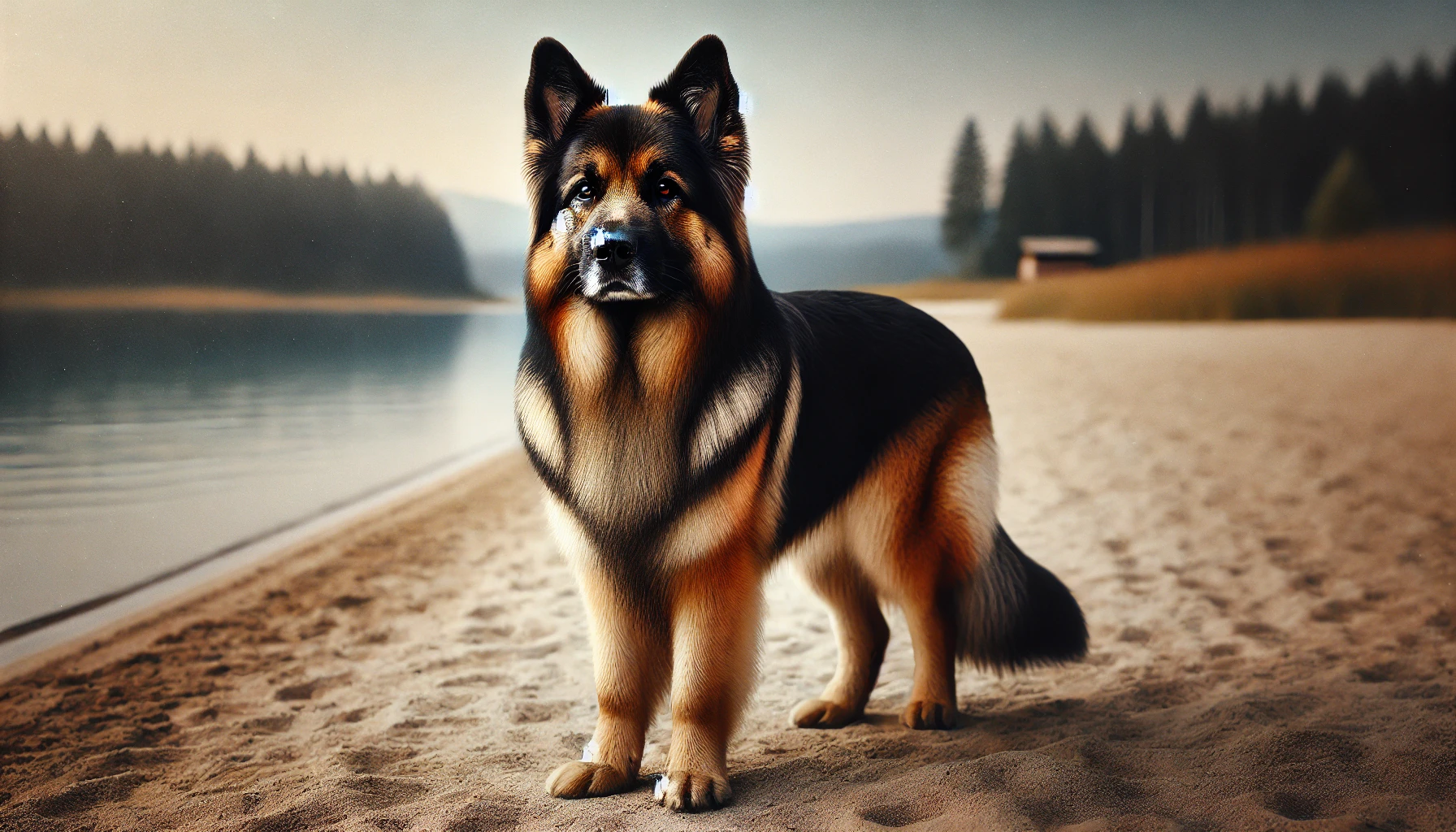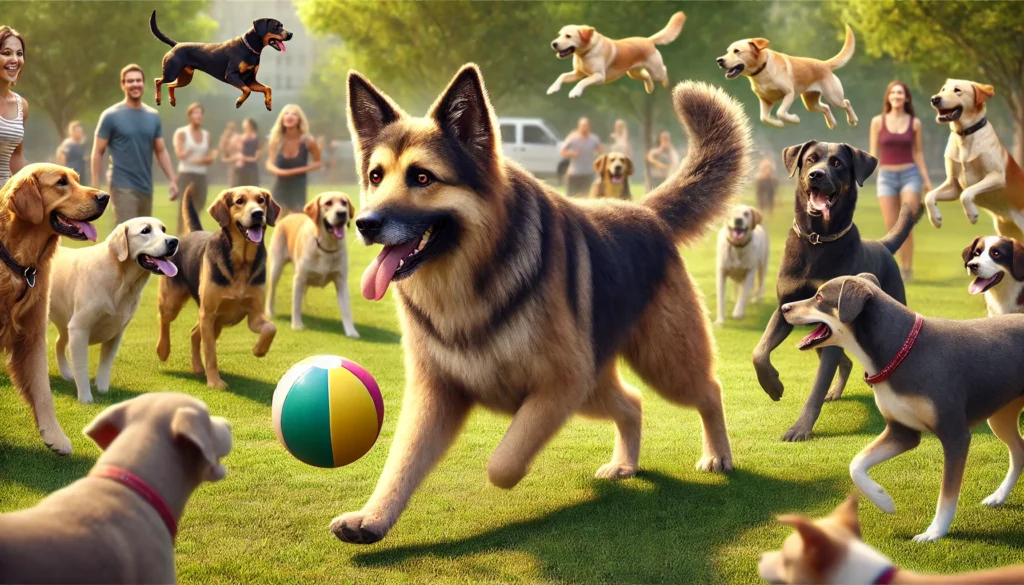Sheprador Dog: Ultimate Health and Care Guide

The Sheprador, a popular mixed breed, is a delightful cross between the German Shepherd and Labrador Retriever. Known for its intelligence, loyalty, and energy, this breed makes an excellent family companion and working dog. However, owning a Sheprador comes with responsibilities, especially when it comes to their health and overall care.
What is a Sheprador Dog?
The Sheprador Dog is a hybrid of two well-loved breeds—the German Shepherd Lab mix. This medium-to-large dog inherits traits from its parents, blending the protective and intelligent nature of the German Shepherd with the friendly and energetic personality of the Labrador Retriever.
Physical Characteristics
- Size: 50–90 pounds
- Height: 20–25 inches at the shoulder
- Coat: Dense, weather-resistant, and varies in length
- Colors: Black, tan, chocolate, yellow, or mixed patterns
- Lifespan: 10–14 years
Health Concerns for Sheprador Dog
While mixed breeds like the German Shepherd Lab mix often benefit from hybrid vigor, they can inherit health conditions common to both parent breeds.
1. Hip and Elbow Dysplasia
One of the most common issues in mixed breed shepherd dogs, hip and elbow dysplasia affects the joints, causing pain and mobility challenges.
- Symptoms: Limping, stiffness, or difficulty rising.
- Prevention: Provide a balanced diet and regular exercise to maintain a healthy weight.
- Treatment: Medication, physical therapy, or surgery in severe cases.
2. Obesity
Both German Shepherd and Lab mixes are prone to weight gain if overfed or under-exercised. Obesity can lead to diabetes, joint issues, and reduced lifespan.
- Prevention: Feed high-quality dog food in appropriate portions.
- Exercise Needs: At least 60 minutes of activity daily.
3. Bloat (Gastric Dilatation-Volvulus)
This life-threatening condition occurs in deep-chested dogs like the black Lab Shepherd mix.
- Symptoms: Swollen abdomen, restlessness, or unproductive retching.
- Prevention: Feed smaller meals and avoid vigorous activity post-meal.
- Emergency Care: Immediate vet attention is crucial.
4. Allergies
Many shepherd mix dog breeds, including the Sheprador, can develop allergies triggered by food, fleas, or environmental factors.
- Symptoms: Scratching, redness, or licking.
- Management: Dietary changes, antihistamines, or allergy shots as prescribed by a vet.
5. Degenerative Myelopathy
A progressive spinal condition often seen in German Shepherd mixes, leading to hind limb weakness.
- Treatment: While there’s no cure, physical therapy and mobility aids can enhance quality of life.

Care Requirements for Sheprador Dog
To keep your Lab Shepherd mix healthy and happy, you’ll need to meet their dietary, grooming, exercise, and training needs.
1. Nutrition
Shepradors are active dogs that thrive on a high-quality diet.
- Food: Choose kibble formulated for large breeds with a balance of protein, fats, and carbohydrates.
- Supplements: Consider omega-3 fatty acids and glucosamine to support joint health.
2. Exercise
A mix of two energetic breeds, the Labrador German Shepherd mix needs plenty of exercise.
- Daily Activity: At least 1–2 hours, including walks, runs, or playtime.
- Mental Stimulation: Use puzzle toys or agility training to keep their minds sharp.
3. Grooming
The coat of a Shepherd Lab mix sheds year-round, with heavier shedding in spring and fall.
- Brushing: Twice weekly to control shedding.
- Bathing: Only when necessary to avoid skin irritation.
- Nail Care: Trim nails regularly.
- Teeth Cleaning: Brush teeth 2–3 times per week to prevent dental issues.
4. Training
Shepradors are intelligent and eager to please, making training enjoyable.
- Start Early: Begin with basic obedience training as puppies.
- Positive Reinforcement: Reward good behavior with treats and praise.
- Advanced Commands: They excel in agility, search-and-rescue, and other advanced activities.
Common Variations and Related Mixes
The Sheprador Dog is just one example of shepherd mix dog breeds. Other popular variations include:
- Black Lab German Shepherd mix: A stunning hybrid with a glossy black coat.
- Yellow Lab Shepherd mix: Known for its golden hue and friendly personality.
- Chocolate Lab Shepherd mix: A unique brown-colored variation.
- Lab Aussie Shepherd mix: Combining the energy of the Australian Shepherd with the Labrador’s loving nature.
- Anatolian Shepherd and Lab mix: A larger breed variation with protective instincts.
Life Expectancy of Sheprador Dog
The average lifespan of a German Shepherd Lab mix is 10–14 years. Proper care, regular vet visits, and a healthy lifestyle can maximize their life expectancy.
Factors Affecting Longevity
- Diet and Weight: Overweight dogs have shorter lifespans.
- Exercise: Active dogs are less likely to develop obesity-related conditions.
- Healthcare: Routine checkups and vaccinations prevent diseases.
Creating the Perfect Environment
Home Setup
Shepradors need space to roam and play. While they can adapt to apartment living, a home with a yard is ideal for this energetic breed.
Social Needs
These dogs are social and thrive on companionship. Leaving them alone for extended periods can lead to separation anxiety.
Do You Know
Not all cat stares are about getting something! Sometimes, they just want to share a little love. Why Does My Cat Stare at Me? When a cat stares at you and then gives a slow blink, they’re saying, “I trust you.” This slow-blinking behavior is sometimes called a “cat kiss.” Cats only close their eyes around people they feel safe with, so if you see this, consider yourself lucky – you’re part of their inner circle.
Is a Sheprador Dog Right for You?
If you’re looking for a loyal, intelligent, and energetic companion, the Sheprador Dog might be perfect. Whether it’s a German Shepherd Lab mix puppy or a full-grown Lab Shepherd mix, these dogs are sure to bring joy to any household. By understanding their unique needs and providing proper care, you’ll ensure they live a happy, healthy life by your side.
Conclusion
The Sheprador Dog, a delightful blend of the German Shepherd and Labrador Retriever, embodies the best traits of both breeds—intelligence, loyalty, energy, and a loving nature. This hybrid is more than just a pet; it’s a devoted companion that thrives in an active, caring environment.
To ensure your German Shepherd Lab mix leads a happy and healthy life, focus on providing a balanced diet, regular exercise, mental stimulation, and consistent training. Stay proactive about their health with routine veterinary care and address any potential issues early. Whether you’re drawn to the Black Lab Shepherd mix, Yellow Lab Shepherd mix, or another variation, this breed promises years of joy and companionship.
Owning a Sheprador requires commitment, but the rewards are immense. Their boundless love, unmatched loyalty, and playful spirit will enrich your life, making them a cherished part of your family for years to come.
Is a Sheprador Dog a good family dog?
The Sheprador Dog, a mix between a German Shepherd and a Labrador Retriever, is renowned for its excellent temperament, making it an ideal family dog. Known for their loyalty, affection, and protective nature, Shepradors often form strong bonds with family members. They are good with children and other pets, especially when socialized from an early age. Their friendly demeanor combined with a keen intelligence makes them not only a joyful companion but also a dependable part of the family dynamics.
What is the breed of Pakistani Sheprador Dog?
The Pakistani Sheprador Dog, commonly referred to as the Pakistani Bully Kutta, is a breed distinct from the more commonly known shepherd breeds. Originating from the Sindh and Punjab regions of Pakistan, it is traditionally used for hunting and guarding. Not technically a shepherd breed, the Bully Kutta is known for its great size and strength, often characterized by a powerful build and a fearless temperament. It’s important to note that they require firm training and are best suited to experienced dog owners.
Are Shepradores aggressive?
Sheprador Dog, being a blend of German Shepherd and Labrador Retriever, generally inherit the friendly and calm traits of the Lab, coupled with the protective nature of the German Shepherd. While not naturally aggressive, Shepradors can be protective of their family. Proper training, early socialization, and consistent handling are essential to ensure they remain well-behaved and sociable. With these measures in place, Shepradors typically display a well-rounded temperament suitable for families.
Is a Sheprador Dog a large breed dog?
Yes, a Sheprador Dog is considered a large breed dog. They typically weigh between 50 and 90 pounds and can stand about 20 to 25 inches tall at the shoulder. Their size is a blend of the German Shepherd’s sturdy build and the Labrador Retriever’s robust form, making them substantial in both weight and height. Potential owners should consider the space and exercise requirements needed to accommodate a dog of this size.
Are Shepradores easy to train?
Shepradores are generally easy to train due to their intelligent and eager-to-please nature inherited from both their German Shepherd and Labrador Retriever lineage. They respond well to positive reinforcement techniques such as treats and praises. Regular, consistent training sessions help harness their intelligence and prevent boredom. Sheprador Dog excel in obedience, agility, and other canine sports, reflecting his trainability and need for mental stimulation.
What is the strongest family dog?
While “strongest” can refer to physical strength or character, one breed noted for both is the Rottweiler. Known for its powerful physique and protective instincts, the Rottweiler makes a formidable guard dog yet is affectionate with its family. It’s important for families to consider both the physical and temperamental needs of a breed to ensure it fits their lifestyle and environment. Regular training and socialization are crucial for maintaining a well-balanced family dog.
What is the personality of a Sheprador Dog?
The personality of a Sheprador Dog typically combines the best traits of its parent breeds—the loyalty and protectiveness of the German Shepherd with the sociability and cheerfulness of the Labrador Retriever. Shepradors are known for their friendly, gentle disposition, making them excellent companions. They are also highly adaptable, intelligent, and keen to participate in family activities. Their balanced temperament makes them suitable for various roles, including family pet, service dog, or therapy animal.
Which Sheprador Dog is strongest?
Among shepherd dogs, the Caucasian Shepherd stands out for its strength and solid build. Originally bred to protect livestock from predators in the Caucasus region, these dogs are large, muscular, and have a reputation for being fearless and resilient. Their size and strength make them effective guard dogs but also mean they require experienced handling and extensive socialization to be well-adjusted pets.
Are Shepradores smart?
Yes, Shepradores are highly intelligent, inheriting their smarts from both the German Shepherd and the Labrador Retriever, both of which are ranked highly for intelligence. This intelligence makes Shepradors quick learners who excel in various dog sports and training disciplines. Their smart nature also means they require mental stimulation to prevent boredom, which can be provided through training, puzzle toys, and regular interaction.
What is the difference between a German Shepherd and a Sheprador Dog?
The main difference between a German Shepherd and a Sheprador Dog lies in their lineage and resulting traits. The German Shepherd is a purebred known for its confidence, intelligence, and capability as a working dog. A Sheprador is a crossbreed between a German Shepherd and a Labrador Retriever, which generally softens the intense traits of the German Shepherd with the Labrador’s friendliness and approachability. This makes Shepradors typically more versatile and adaptable to various family environments.
Which dog is best for home German Shepherd?
The German Shepherd can be an excellent home pet, especially for active households. Known for their loyalty and protective nature, they require significant exercise and mental stimulation. Their ability to be trained for various tasks and roles makes them adaptable to home environments, provided they receive proper training and socialization. They’re particularly well-suited to homes looking for a dog that is both a companion and a guardian.
What is the most loving family dog?
Labrador Retrievers are often considered the most loving family dog due to their friendly nature, reliability, and strong bond with humans. They are consistently ranked as one of the most popular family dogs thanks to their gentle demeanor, patience, and adaptability. Labs are particularly good with children and make excellent companions for family members of all ages.
Which dog is best for domestic?
For a domestic setting, the Golden Retriever is an excellent choice. They are renowned for their friendly, tolerant attitude, and their intelligence makes them easy to train. Golden Retrievers are well-suited to family life and are known for their devotion and obedience. They thrive in a home where they can be part of daily activities and where their social and physical needs are met.
Is German Shepherd smarter than Labrador?
Both the German Shepherd and the Labrador Retriever are highly intelligent, ranking in the top tier of dog breeds for smarts. The German Shepherd might edge out slightly in terms of work intelligence and trainability, commonly used in roles such as police and military services. Labradors excel in obedience and are preferred for roles like guide dogs and therapy work, highlighting their intelligence and trainability. In a domestic setting, both breeds show remarkable adaptability and learning capability.
Which dogs have the highest IQ?
Among dog breeds, those recognized for having the highest IQ are often those bred for specific tasks that require intelligence and decision-making skills. The Border Collie tops the list, renowned for its problem-solving abilities and agility. Following closely are the Poodle, known for its exceptional trainability and keen intelligence, and the German Shepherd, valued for its versatility and learning speed. Golden Retrievers and Doberman Pinschers also make the list, celebrated for their obedience and capability to learn complex commands quickly.
Who will win, a Rottweiler or a German Shepherd?
Considering a hypothetical scenario in which a Rottweiler and a German Shepherd might “compete,” it’s important to note that both breeds are strong, intelligent, and capable, each excelling in different aspects. Rottweilers are more powerful, known for their strength and endurance, while German Shepherds are agile, intelligent, and versatile, often used in police and service roles. However, encouraging dogs to compete in physical confrontations is neither ethical nor advisable. Instead, focusing on each breed’s strengths and training them for cooperation and companionship is more beneficial.
Which dog is better than Labrador?
Determining if one dog breed is “better” than another, such as a Labrador Retriever, depends largely on the needs, lifestyle, and preferences of the potential owner. Labradors are highly adaptable, friendly, and trainable, making them excellent family pets. However, for someone interested in a more protective breed, a German Shepherd might be “better.” For those seeking a smaller, less active dog, breeds like the Cavalier King Charles Spaniel or the Pug might be more suitable. Essentially, the best breed is one that aligns well with an individual’s or family’s lifestyle and needs.






